Market
Colombia Eyes Digital Assets Regulation Law
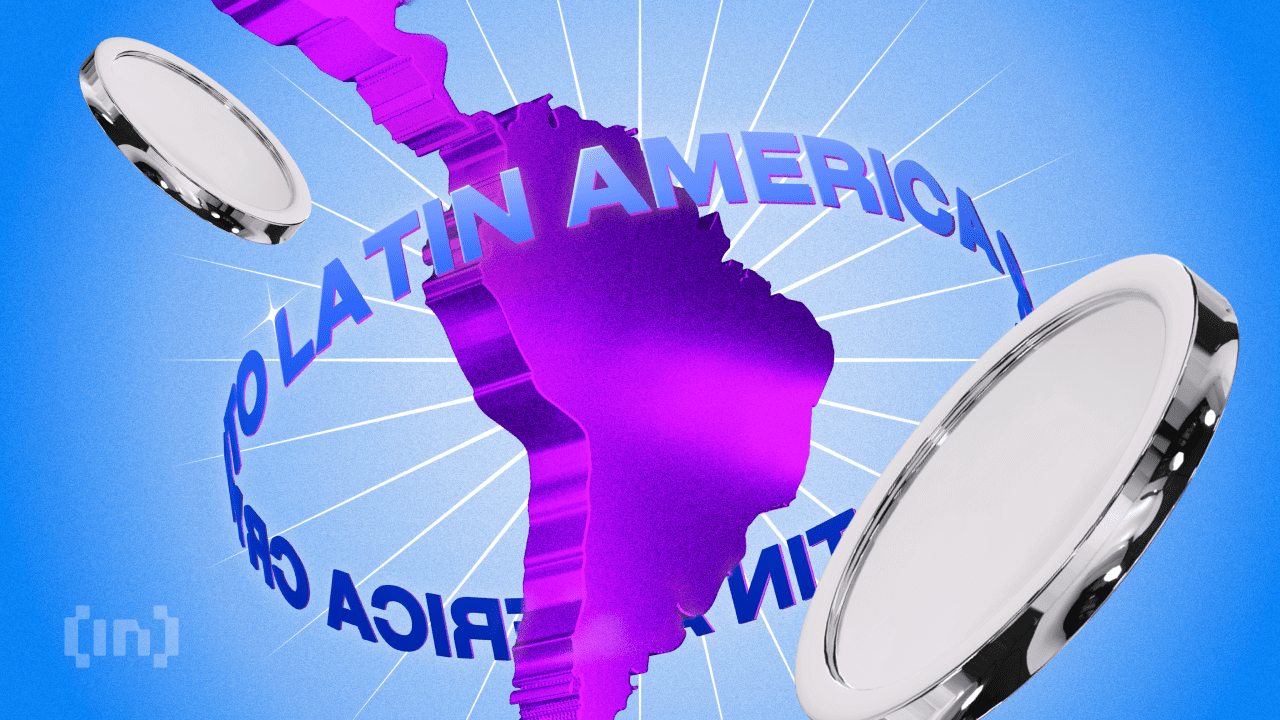
BeInCrypto comprehensive Latam Crypto Roundup brings Latin America’s most important news and trends. With reporters in Brazil, Mexico, Argentina, and more, we cover the latest updates and insights from the region’s crypto scene.
This week’s roundup includes stories on El Salvador’s plans to strengthen trade relations with Russia using Bitcoin, Binance’s survey of Latin American customers, Colombia’s efforts to develop a clear regulatory framework, and more.
Latam Investors Plan to Buy More Crypto, Says Binance
A Binance survey reveals that nearly all Latam investors intend to increase their crypto holdings in the coming year. The study interviewed around 10,000 Binance customers from Argentina, Brazil, Colombia, and Mexico. The participants, who had varying levels of investment, provided insights into their behavior and outlook on the crypto market.
According to Binance, 95% of surveyed customers plan to boost their cryptocurrency investments in the next 12 months. Of these, 42.2% expect to make purchases within the next three months, 17% within six months, and 35.7% within the year.
The research also highlighted the buying habits of investors. More than 54% purchase cryptocurrencies at least once a month. Notably, 6.6% buy more than once a day, 4.6% buy daily, 15.4% buy weekly, and 27.8% buy monthly.
When deciding which cryptocurrencies to buy, a third of the customers base their decisions on market conditions. Additionally, over 50% of the participants have been investing in cryptocurrencies for more than a year.
Read more: Best Crypto To Buy Now: Top Coins To Keep an Eye on in August 2024
The survey also explored the reasons behind their investments. Approximately 20.3% cited prospects of high profitability, 15.2% mentioned financial freedom, while 13.3% were motivated by money protection. Other reasons included innovation (12.5%), portfolio diversification (10.9%), and security and privacy (10.3%).
“Cryptocurrencies and blockchain technology offer an attractive proposition to meet concrete needs in the day-to-day lives of individuals and businesses in Latin America. With a smartphone and minimal requirements, anyone can begin to explore this world that offers lower access, costs, and transaction times. This research not only helps us to expose the current state of cryptocurrency adoption in the region but also allows us to provide insights into user behavior and expectations,” Guilherme Nazar, Binance’s regional vice president for Latin America, commented.
Worldcoin Executive Reveals Operations Without License in Ecuador
The Data Protection Superintendence of Ecuador denies receiving formal notification about Worldcoin’s operations, despite claims from Martin Mazza, regional manager for Latin America of Tools for Humanity (TFH).
For over a month, citizens in Guayaquil and Quito have had their irises scanned in exchange for cryptocurrencies via a mobile app. Users, often unaware of the terms and purposes of their biometric data usage, have received over $24 in crypto.
This raises concerns about compliance with personal data protection regulations. Fabrizio Peralta Díaz, Superintendent of Data Protection, noted the institution’s lack of resources for effective supervision, adding that he is the only official available for these duties. Peralta confirmed that contact with Worldcoin was limited to a briefing on June 17, 2024, not an official notification or request for authorization.
Read more: What Is Worldcoin? A Guide to the Iris-Scanning Crypto Project
Mazza claimed Worldcoin operates in Ecuador under a franchise model, without needing a local branch, and complies with applicable regulations, thus requiring no specific license. He stated that users can access information about the service at location centers.
The superintendence warned that if personal data processing irregularities are found, corrective measures could include ceasing data processing, as per Article 65 of the Organic Law on Personal Data Protection. However, Peralta emphasized that implementing these measures requires a technical report and due process, which are limited by the institution’s financial and human resource constraints.
JusToken Enters Brazil and Argentina
JusToken, a new global tokenization infrastructure company, is entering the real-world asset (RWA) space in Brazil and Argentina. The company aims to provide solutions in collaboration with various sector companies.
“Tokenization allows us to connect the real world with the digital world, creating a new universe of possibilities,” said JusToken’s CEO and co-founder, Eduardo Novillo Astrada. “To achieve this, a solid, scalable, and proven infrastructure that can adapt to diverse needs is essential. Justoken was born to tokenize, empower, and expand businesses. We offer solutions tailored to each industry’s needs, powered by blockchain, which gives us transparency, agility, speed, and security.”
Read more: How To Invest in Real-World Crypto Assets (RWA)?
JusToken comprises several firms, including Agrotoken, which tokenizes agricultural products; Landtoken, a farmland tokenization platform; Pectoken, a livestock tokenization platform; Enertoken, a global energy tokenization platform; and SAYKY, which offers carbon-based and ESG solutions.
The company’s goal is to convert physical assets into digital assets with liquidity and security through blockchain.
Chilean Congressman Investigated for Holding Millions in Cryptocurrency
Amid the investigation into an alleged mega-fraud involving former Maipú mayor Cathy Barriga, a new controversy has surfaced concerning her husband, Congressman Joaquín Lavín León.
Between 2018 and 2021, Lavín reportedly invested over $48 million in cryptocurrencies through the Buda.com platform. The substantial volume of these investments caught the attention of authorities, especially after the platform requested information on the origin of the funds. Lavín’s failure to respond led to the temporary blocking of his account.
Cathy Barriga’s lawyer, Cristóbal Bonacic, has defended the legitimacy of these investments, asserting that all the money in question comes from Lavín’s legitimate income. Bonacic explained that Lavín’s lack of response to the source of funds request was due to him no longer making investments on Buda.com, not due to any lack of clarity about the funds.
Read more: Complete Guide to Filing Cryptocurrency Taxes in 2024
Suspicion also surrounds a $12,600 transaction made in September 2018 by Vicente González, Barriga’s eldest son. Vicente, who was 19 at the time, made the transaction from his Buda.com account before he began his relationship with the Internal Revenue Service.
Neither Cathy Barriga nor Joaquín Lavín have made additional statements. Bonacic concluded that there is no objection to the Public Prosecutor’s Office investigating thoroughly, maintaining that there has been no irregular or illegal action in the context of these investments.
El Salvador Willing to Pay Russia in Bitcoin for Bilateral Business
El Salvador, having already legalized Bitcoin as legal tender, is now prepared to use cryptocurrencies for trade with Russia. Alexander Ilyukhin, first secretary of the Russian Embassy in Nicaragua and head of the branch in El Salvador, announced this during an interview with local media outlet Izvestia.
Given that El Salvador’s official currency is the US dollar, Ilyukhin mentioned that the country faces challenges with payments. To address these issues, El Salvador proposes that Russia adopt cryptocurrencies for transactions.
This initiative symbolizes a move toward alternative international payment methods amid sanctions and restrictions. However, the practical benefits of such declarations are often negligible, even if implemented.
Read more: Who Owns the Most Bitcoin in 2024?
In recent years, El Salvador and Russia have been strengthening trade relations. At the St. Petersburg International Economic Forum, El Salvador’s Vice President Felix Uyoa confirmed a commitment to expand trade ties with Russia, especially with innovation-driven companies. Russian Foreign Minister Sergei Lavrov also noted the potential for increased trade, emphasizing the need for direct contacts between the business communities of both countries.
Despite these efforts, current trade volumes between the nations are minimal. In the fourth quarter of 2023, Russia exported goods worth approximately $1 million to El Salvador, while imports from El Salvador did not exceed $20,000. El Salvador mainly exports coffee and its substitutes to Russia, while Russia supplies fertilizers and machinery to El Salvador.
Google and Itaú Brazil Integrate Central Bank Digital Payments
On July 30, Google announced the integration of Pix, Brazil’s instant payment system, into its digital wallet. This new feature aims to simplify transactions, allowing users to make payments and transfers quickly and securely without needing to open their bank’s app.
To enable this integration, Google obtained a specific payment indicator license from the Central Bank. Users can now add their Pix keys to Google Wallet, making payments at merchants and online stores that accept Pix. Additionally, they can send and receive money from friends and family instantly, 24/7.
Google Pay, the tech giant’s platform for online and contactless payments, will ensure transaction security with encryption and two-factor authentication. Google highlights that Pix in Google Wallet offers a convenient way to make payments without cash or cards.
Read more: Crypto vs. Banking: Which Is a Smarter Choice?

The functionality will launch gradually, initially available only to C6 Bank and PicPay customers. Elisa Jóia, Google’s head of payments operations for Latin America, stated that this first stage aims to test the functionality and gather user feedback.
“The idea is to do a small launch, so we can understand what the user feedback will be like, to ensure as much security as possible,” Jóia said.
Integrating Pix into Google Wallet will create a fully digital wallet, offering users the choice between credit, debit, and Pix. With the popularity of Google’s digital wallet and Pix’s wide acceptance, this new feature has the potential to drive financial inclusion and simplify transactions for millions of Brazilians.
Colombian Banks and Regulators Consider Cryptocurrency Law
Colombia is positioning itself as a leader in crypto adoption in Latam but faces significant regulatory challenges concerning cryptocurrencies and digital assets. To address these issues, banking entities are pushing for regulations that would make the Colombian Financial Superintendency’s Sandbox more practical and extensive.
Despite the absence of a clear regulatory framework, local media such as Portafolio report that Colombian financial institutions are advancing in their integration of cryptocurrencies. Bancolombia, Davivienda, and Itaú have begun to develop their own exchange platforms despite regulatory uncertainties. For instance, Bancolombia has launched Wenia, a platform designed to facilitate cryptocurrency transactions, backed by a stablecoin pegged to the Colombian peso.
Davivienda has demonstrated its technological capabilities and is awaiting a more mature regulatory environment to fully enter the crypto market. However, these initiatives face the obstacle of an unstable regulatory framework. The recent LaArenera ‘sandbox’ stage, created by the Superintendencia Financiera to test new technologies in a controlled environment, highlighted the limitations of the current regulations.
Read more: Crypto Regulation: What Are the Benefits and Drawbacks?
Although the pilot involved alliances like Banco de Bogotá with Bitso and Davivienda with Binance, progress toward widespread cryptocurrency adoption remains slow.
As the Latam crypto scene grows, these stories highlight the region’s increasing influence in the global market. Stay tuned for more updates and insights in next week’s roundup.
Disclaimer
In adherence to the Trust Project guidelines, BeInCrypto is committed to unbiased, transparent reporting. This news article aims to provide accurate, timely information. However, readers are advised to verify facts independently and consult with a professional before making any decisions based on this content. Please note that our Terms and Conditions, Privacy Policy, and Disclaimers have been updated.
Market
Analyst Reveals ‘Worst Case Scenario’ With Head And Shoulders Formation
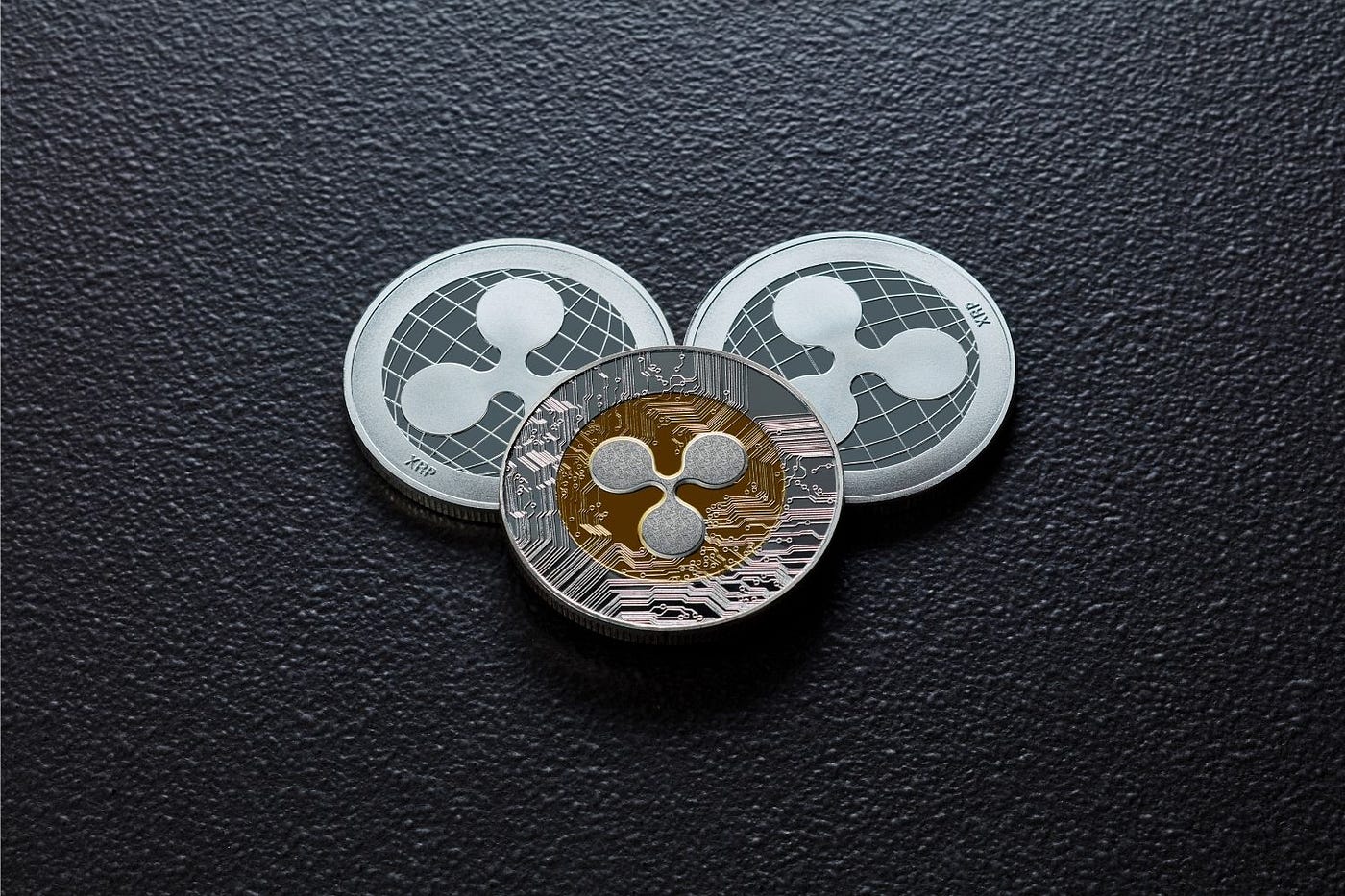
Reason to trust

Strict editorial policy that focuses on accuracy, relevance, and impartiality
Created by industry experts and meticulously reviewed
The highest standards in reporting and publishing
Strict editorial policy that focuses on accuracy, relevance, and impartiality
Morbi pretium leo et nisl aliquam mollis. Quisque arcu lorem, ultricies quis pellentesque nec, ullamcorper eu odio.
Recent XRP price action has sparked a new prediction from a crypto analyst, as a potential Head and Shoulders pattern emerges on the chart. The analyst warns that this technical formation could trigger a significant price correction for XRP, describing this downturn as the worst-case scenario.
Analyst Predicts XRP Price Crash To $1.15
The ‘Charting Guy,’ a pseudonymous crypto analyst on X (formerly Twitter), has unveiled a potential Head and Shoulder pattern formation on the XRP price chart. The analyst has shared insights into the implications of this technical pattern, projecting a potential crash in the XRP price.
Related Reading
As a well-known bearish reversal pattern, the formation of a Head and Shoulder in the XRP price chart suggests a potential shift from an uptrend to a downtrend. Typically, a Head and Shoulder pattern consists of three peaks: the Left Shoulder, Head, and Right Shoulder. However, the Charting Guy has confirmed that XRP’s current pattern formation consists of two right shoulders and one head. Due to this irregularity, the analyst has expressed doubt about the possibility of the pattern playing out.
If the Head and Shoulder pattern eventually takes shape, it could lead to a significant drop in the XRP price, potentially bringing it down to as low as $1.15. This price level aligns with a key Fibonacci Golden Pocket retracement zone between 0.618 – 0.786.
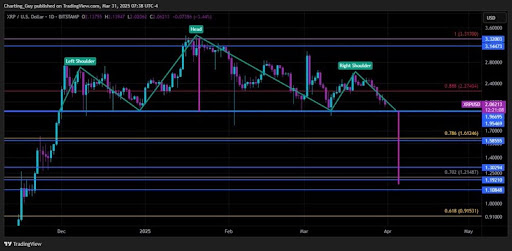
Notably, the analyst has described this projected price crash as the worst-case scenario for XRP. While he believes a bearish move is possible, the analyst is confident that XRP’s broader market structure is bullish.
Moreover, the Charting Guy argues that if XRP does decline to $1.15, it would likely serve as a healthy retracement in an overall bullish trend. He noted that XRP’s price has been holding the $2 level on daily closes, meaning its price action remains strong above support levels. This also indicates the possibility of an uptrend resumption that could yield higher highs and higher lows for XRP.
Key Support And Resistance Levels To Watch
The Charting Guy’s analysis of XRP’s potential Head and Shoulder pattern formation highlights several critical price levels to watch. Since XRP has consistently closed daily candles above $2, the analyst has determined this level as short-term support.
Related Reading
XRP has also been wicking during recent pullbacks in a crucial range between $1.7 and $1.9. As a result, the crypto analyst has revealed that he will be watching this area closely for a potential price bounce.
The Golden Pocket retracement zone, which represents the worst-case scenario for the XRP price, is between $1.15 and $1.30. If XRP experiences a deeper price correction, lower support levels have been marked from $1.19 to $0.91.
For its resistance levels, the Charting Guy has pinpointed $2.27 as a key price point. Additionally, $3.14 – $3.32 has been identified as an upper resistance range where XRP could rally if bullish momentum resumes.
Featured image from Medium, chart from Tradingview.com
Market
BeInCrypto US Morning Briefing: Standard Chartered and Bitcoin


Welcome to the US Morning Crypto Briefing—your essential rundown of the most important developments in crypto for the day ahead.
Grab a coffee to see how Standard Chartered sees early signs of institutional investors turning to Bitcoin as a hedge against equity market volatility, just as traders gear up for a potentially volatile week driven by tariff news. At the same time, Coinbase wraps up its worst quarter since the FTX collapse, and U.S. regulators inch closer to unified stablecoin legislation.
Standard Chartered Sees Signs of Bitcoin Starting to Be Used as Hedge Against Market Volatility
Geoff Kendrick, Head of Digital Assets Research at Standard Chartered, sees signs that institutional traders are starting to use Bitcoin as a hedge against equity market volatility.
In a recent exclusive interview with BeInCrypto, Kendrick highlighted that this trend is already underway, with investors seeking alternatives to traditional instruments. “This is happening already,” Kendrick stated. “Investors used to use FX, specifically AUD, for this purpose due to its highly liquid and positive correlation to stocks, but now I think Bitcoin is being used because it is also highly liquid and trades 24/7.”
Additionally, in an investor note from late March, Kendrick expanded on Bitcoin’s evolving role in investment portfolios, suggesting that over time, Bitcoin may serve multiple purposes—both as a hedge against traditional financial market fluctuations and as a proxy for tech stocks.
He pointed out signs that markets could anticipating a less severe tariff announcement from the U.S. on April 2. “Given this has been the worst quarter for the Nasdaq since Q2 2022, there should be a degree of portfolio rebalancing (buying) that needs to take place,” Kendrick added.
As of April 1, 2025, Bitcoin has shown resilience amid broader market uncertainties. The cryptocurrency is up approximately 3.32%, trading at $84,282. This uptick comes alongside an overall increase in the global cryptocurrency market capitalization. In contrast, U.S. stock futures, including Dow Futures, S&P 500 Futures, and Nasdaq Futures, are all trending lower in pre-market trading, reflecting investor caution ahead of the anticipated tariff announcements.
Bitcoin Options Heat Up Before Trump’s “Liberation Day”
FalconXCrypto Global Co-Head of Markets, Joshua Lim, noted that in anticipation of Wednesday’s Trump-tariff “Liberation Day,” crypto funds are actively purchasing Bitcoin options at two key strike prices: $75,000 on the downside to hedge against potential losses and $90,000 on the upside to capitalize on a price surge.
Lim highlighted that the options market is pricing in a potential 4% move in Bitcoin’s price during the event. “The implied event move embedded in Bitcoin options is around 4% for the 2 April event,” he told BeInCrypto.
He also pointed out that traders are likely to keep buying put options in the short term as a protective measure, maintaining a high options cost premium. “We believe the front of the options curve will hold its premium as traders continue to hedge their portfolios or replace spot positions with limited-loss option positions,” Lim added.
Additionally, he noted a 4-point increase in the VIX, signaling that investors expect heightened volatility in the coming days and are turning to options to manage risk or capitalize on price swings. “US equities are also showing a bid in options, with the front-month VIX up 4 points to 22v from last week,” he said.
Crypto Stocks Slide: Coinbase Suffers Worst Quarter Since FTX Collapse
Coinbase is closing out its roughest quarter since the FTX collapse, with its stock tumbling over 30% since January. While it dipped nearly 1% in early U.S. pre-market trading on Monday, the stock managed to claw back losses and is now up around 1%.
Other crypto-linked companies are also feeling the pressure. Galaxy Digital Holdings has dropped over 8% in pre-market trading, while mining firms Riot Platforms and Core Scientific are only barely staying afloat, each gaining less than 0.5%.
Meanwhile, CoreWeave, which pivoted from Bitcoin mining to AI infrastructure, is struggling after a disappointing IPO. Initially aiming for a $2.7 billion raise, the company had to settle for $1.5 billion, slashing its offer price from the $47–55 range to $40 per share. Since going public last Friday, its shares are down 6.8%, with a 7.3% drop recorded in the last 24 hours.
Byte-Sized Alpha
– Today’s JOLTS report, a key gauge of U.S. job openings, could sway Bitcoin—strong data may boost the dollar and hurt crypto, while a sharp decline could fuel rate-cut hopes and lift risk assets.
– Bitcoin is off to its worst quarterly start since 2018, dropping nearly 12% in Q1 2025—but growing whale accumulation, falling exchange supply, and signs of consolidation hint at a potential rebound ahead.
– Crypto scams are on the rise, with fake Gemini bankruptcy emails and a Coinbase employee breach fueling phishing attacks
– OKX has appointed former NYDFS Superintendent Linda Lacewell as Chief Legal Officer, a move aimed at bolstering its regulatory credibility as the exchange accelerates global expansion into regions like Europe and the UAE.
– A unified U.S. stablecoin regulation could soon become reality, as the STABLE and GENIUS Acts differ by only 20% and enjoy strong bipartisan support alongside SEC and CFTC involvement.
– A push for expanded crypto oversight is underway as incoming CFTC Chair Brian Quintenz meets with Senator Chuck Grassley to discuss regulating the crypto spot market.
Disclaimer
In line with the Trust Project guidelines, this price analysis article is for informational purposes only and should not be considered financial or investment advice. BeInCrypto is committed to accurate, unbiased reporting, but market conditions are subject to change without notice. Always conduct your own research and consult with a professional before making any financial decisions. Please note that our Terms and Conditions, Privacy Policy, and Disclaimers have been updated.
Market
SUI Price Stalls After Major $147 Million Token Unlock

SUI enters a critical phase today as a $147 million token unlock threatens to inject selling pressure into a market already testing key resistance levels. Despite a sharp rebound in momentum—evident in the RSI’s surge from oversold territory—SUI failed to break above the crucial 60 mark, signaling buyer hesitation.
The Ichimoku Cloud shows price action pressing against the cloud’s edge, but lacking the conviction needed for a clear breakout. With a possible golden cross forming on the EMA lines, bulls still have a chance—if they can overcome resistance at $2.50 and avoid being dragged down by post-unlock volatility.
SUI RSI Surged Since Yesterday But Failed To Break Above 60
SUI’s Relative Strength Index (RSI) has jumped sharply to 58.94, up from 29.38 just a day ago, reflecting a strong shift in short-term momentum.
The RSI is a momentum oscillator that measures the speed and magnitude of recent price changes. It typically ranges from 0 to 100. Readings below 30 suggest an asset may be oversold, while levels above 70 indicate it may be overbought.
The rapid rise in SUI’s RSI suggests buyers have stepped in aggressively after a period of heavy selling.

However, despite the impressive rebound, SUI’s RSI briefly approached but failed to break above the 60 threshold earlier today.
This level often acts as a short-term resistance during recovery phases, and the rejection may indicate lingering hesitation among buyers or profit-taking after the surge.
While the RSI nearing 60 is encouraging, a decisive move above it would be needed to confirm a breakout. For now, SUI appears to be in a recovery mode. However, the inability to push past 60 highlights that bulls are not fully in control just yet.
Ichimoku Cloud Shows Lack Of Strong Upward Momentum
SUI blockchain Ichimoku Cloud chart shows a potential breakout attempt, as the price has surged upward and is now hovering right at the edge of the Kumo (cloud).
This movement suggests bullish momentum is trying to build. However, the resistance provided by the thick, red cloud ahead could make it difficult for SUI to sustain the uptrend without stronger confirmation.
The Tenkan-sen (blue line) is starting to rise and has crossed above the Kijun-sen (red line), which is a bullish signal. However, the price still needs to clearly break and hold above the cloud to flip the overall trend from bearish to bullish.

For now, the cloud remains bearish and flat, indicating possible resistance and a lack of strong upward conviction.
The current position suggests that SUI is at a key decision point—either break through the cloud to initiate a trend reversal or get rejected and slip back into the previous downtrend range.
If buyers can sustain the pressure and push the price above the upper cloud boundary, it could trigger a stronger rally. But without increased volume and broader market support, the price risks getting stuck in consolidation or turning back downward.
Will SUI Rise Back To $2.80?
SUI’s EMA lines are tightening and showing signs of a potential golden cross. That happens when a short-term moving average crosses above a longer-term one—a classic bullish signal that often precedes upward momentum.
However, the price is currently grappling with a key resistance near the $2.50 level.
If bulls manage to break through this level, it could open the path for a move toward $2.83.

That said, downside risks remain, particularly with today’s $147 million token unlock, which could introduce significant selling pressure. If that selling materializes, SUI price could fall back to test the support at $2.23.
A breakdown below that level would likely shift momentum back in favor of bears. This would expose deeper supports at $2.11 and $1.96.
Disclaimer
In line with the Trust Project guidelines, this price analysis article is for informational purposes only and should not be considered financial or investment advice. BeInCrypto is committed to accurate, unbiased reporting, but market conditions are subject to change without notice. Always conduct your own research and consult with a professional before making any financial decisions. Please note that our Terms and Conditions, Privacy Policy, and Disclaimers have been updated.
-

 Market24 hours ago
Market24 hours agoTop 3 Made in USA Coins to Watch In April
-
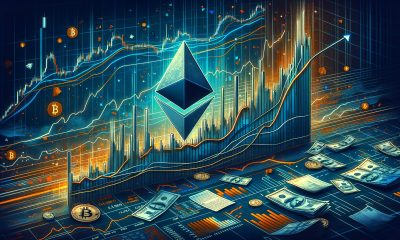
 Market22 hours ago
Market22 hours agoEthereum Price Faces a Tough Test—Can It Clear the Hurdle?
-
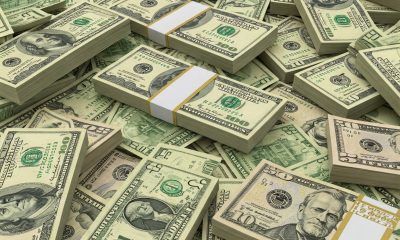
 Bitcoin14 hours ago
Bitcoin14 hours ago$500 Trillion Bitcoin? Saylor’s Bold Prediction Shakes the Market!
-
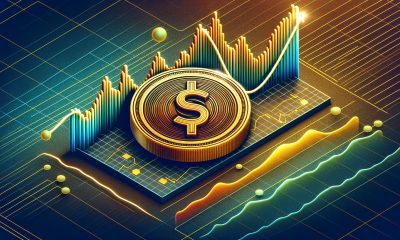
 Market21 hours ago
Market21 hours agoSolana (SOL) Holds Steady After Decline—Breakout or More Downside?
-

 Ethereum20 hours ago
Ethereum20 hours ago$2,300 Emerges As The Most Crucial Resistance
-

 Market20 hours ago
Market20 hours agoCFTC’s Crypto Market Overhaul Under New Chair Brian Quintenz
-

 Altcoin12 hours ago
Altcoin12 hours agoWill XRP, SOL, ADA Make the List?
-

 Altcoin20 hours ago
Altcoin20 hours agoA Make or Break Situation As Ripple Crypto Flirts Around $2





















